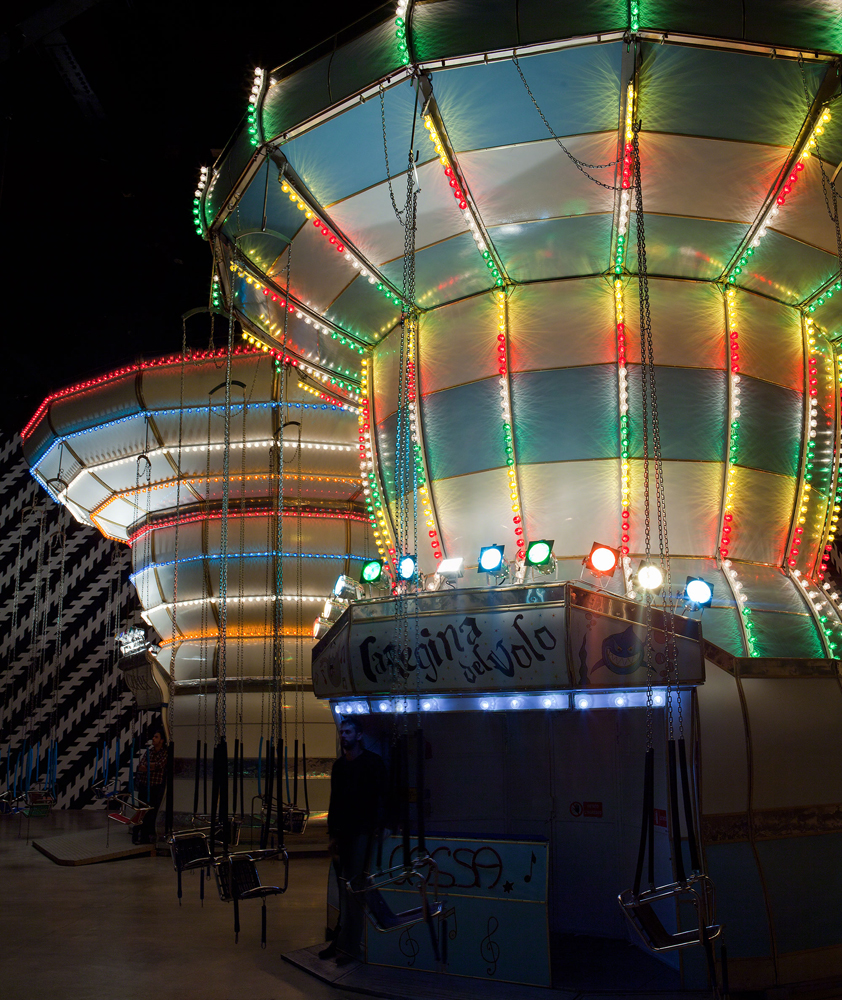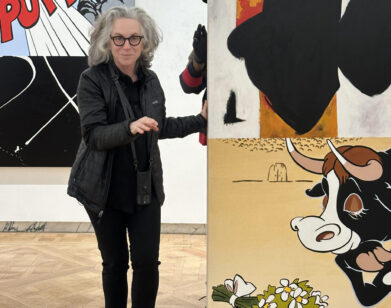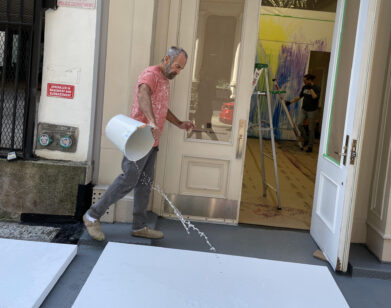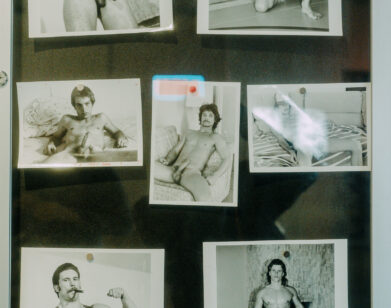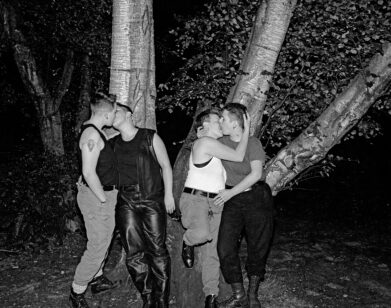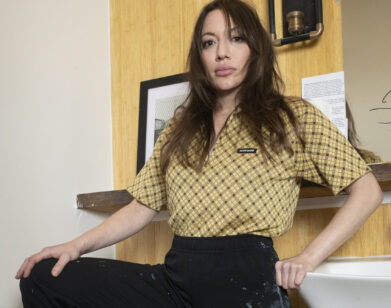Carsten Höller’s Reasonable Doubt
Upon entering Carsten Höller’s latest exhibition, “Doubt,” in the dim, cavernous Pirelli HangarBicocca art space in Milan, visitors are confronted with two brightly lit pieces, Y and Division Walls, and a choice: to go through an opening on the right or the left. One then emerges within an immersive installation titled Decision Corridors—a dark, metal tunnel that leads to two separate sides of the former industrial factory. The viewer’s initial choice signals the forthcoming interactivity and disorientation, which could include a slow, dizzying carousel (Double Carousel), goggles that turn views of the surrounding environment upside-down (Upside-Down Goggles), an anti-climactic flying simulation (Two Flying Machines), and two slow-moving beds that are available to sleep in each night (Two Roaming Beds (Grey)).
Despite the appearance of these pieces in his previous exhibitions (including a significant solo show at the New Museum in New York from 2011-2012), Höller has uniquely organized the space at Pirelli HangarBiccoca. Visitors must rely on memory to piece together the two sections of the exhibition, which begins with the division of Decision Corridors and then transitions into the multiplication of reflective pieces like Aquarium and Revolving Doors. Viewers are meant to question the way they perceive reality, and thus, experience the uncertainty and doubt for which the exhibition was named.
Beginning his career as a scientist in the field of phytopathology (the study of plant diseases), Höller started creating art in the late ’80s and often applies scientific principles and language to his works. We sat down with the Brussels-born, Stockholm-based artist before the opening of “Doubt” to discuss how he structured the exhibition and the effects of the duality he proposes in the experience.
CEDAR PASORI: On first impression, “Doubt,” like your previous exhibitions, seems to emphasize one’s individual experience—witnessing your own and others’ reactions to the work—sometimes through literally mirrored surfaces. Yet in pieces like Twins and Fara Fara, you introduce the faces of twins and Congolese musicians. How do these fit into the exhibition as a whole?
CARSTEN HÖLLER: The twins are really about faces. It’s a bit hard to figure out in the space, because the works are very far away from each other. Whenever I show this work, I do a new version, so if you count how many twins there are—that’s the number of versions we’ve done. The first ones were Japanese. There’s one twin saying, “I always say the same of what you say,” and then the other one says, “I always say the opposite of what you say,” so they’re caught in a loop of repetition and contradiction.
Many of the works in the show, you only really see from one side. You’re supposed to be on the side that you chose in the beginning, when you had to decide which entrance to take. I wanted to split the works up, so that you have to see one side of the work, and then you go around and see the other side, and put them both together in your head.
The Twins are tricky, because when you go to the other side, they have been saying what they say a number of times. If you speak more than one of the languages they’re speaking, for instance, if you understand English and French, it’s like a conversation between them. It’s quite cacophonic. You don’t necessarily have to connect them.
PASORI: Many watched Fara Fara for the first time at last year’s Venice Biennale. How did you become familiar with Congolese rhumba music, and why did you position the two parts of the film across from each other? In a way, it also represents the soundclash.
HÖLLER: All the works had to somehow “bend” over this rigid logic, which is the division between two sides. In Venice, you could probably see Fara Fara more easily, because there were two screens next to each other. Here, it’s difficult to see the other screen, but that’s intentional, of course. “Fara fara” means vis-à-vis, face-to-face. If you stand at a certain point, you can see both films simultaneously.
Congolese rhumba started in the ’30s based on traditional rhythms that transformed under the influence of Cuban music. There’s been a lot of back and forth between Congolese music, so it sounds quite Cuban, in a way, but then Cuban music also sounds quite Congolese. I heard this music for the first time in a discotheque in Benin. It was actually the music of Koffi Olomide, who is one of the two protagonists in the film. I love the structure of it, the way they compose a song. Very often they start with a long introduction—it can be really awkward in the beginning—but then it turns and turns again, until the end, which is what they call “sebene” in the film, the improvisation part. The musicians play together, and it very much becomes dance music.
PASORI: In many ways, the music is happy and uplifting, but then Paba Wemba describes the competitive aspect and calls music “the most powerful weapon.” How does Fara Fara fit into the rest of the works in “Doubt” that have more of an amusement park allure and aesthetic?
HÖLLER: I think Fara Fara has more of an amusement quality than the other works. They may look like they have amusement park qualities, but as you’ve seen, they very often don’t have them. The carousels look like fun from afar, but when you come close, you see that they’re really slow and don’t move very much. Often when children come to my shows with their parents, they’re very excited at first, but then they become disappointed. The bodily part of the entertainment side is gone.
The music comes through massively at parts. I still want to make a bigger, feature-length Fara Fara film about this incredible Congolese music that I’m totally in love with. It’s the only music I listen to at home. I’ve become a real aficionado. It’s music we never hear anywhere in the West; it doesn’t make it into our ears. You don’t hear it on the radio, it’s not something people talk about. It feels segregated from our world, but it’s very interesting and very contemporary. It’s not traditionally African. It’s developed into being more sophisticated and danceable. There are twists in the music that are absolutely not based on repetition. It’s very often based on the evolution of one song that lasts 15 or 20 minutes. There are sometimes 25-50 people on stage playing at the same time.
PASORI: You’ve previously divided your works and exhibitions, for instance, “Divided Divided” in Rotterdam in 2010, but what was the concept behind doing so here at HangarBicocca with what you have called a “control group”?
HÖLLER: It just occurred to me that it is like a scientific experiment, but there’s really no different variable to test here between the right and left sides. It’s more about comparing your memory and experiences from one side to the other. It’s very subjective. It’s not really scientific, but it is a scientific setup.
PASORI: Why is this exhibition called “Doubt”? You’ve done other retrospective-style exhibitions before, but how does this arrangement of division and multiplication and memory versus reality play into the idea of doubt, in particular?
HÖLLER: I always like to choose topics so that it seems like the exhibition is about one thing. Another exhibition was called “Glück,” which means “happiness, fortune, and luck” in German. I also did “Wrong” in Berlin and “Decision” in London, so many of the exhibitions have one-word titles. They make you think that the exhibition is about something very specific, but then you realize that it’s actually more open or dissolves into something else. Even the title itself has poignancy, because it asks itself if it is really the title of the show. I get this question often, but I like it, because it means that the title works—you’re doubting why it’s called “Doubt.”
PASORI: Similar to the two parts of the show, you’ve referred to yourself as having a separate “alien body” inside you that leads the creation of your work, as if you are the “host of a parasite.” When did you recognize this, or decide to see it this way, and how does this idea help you continue to be an artist?
HÖLLER: It’s really just an empiric effect. Whenever I would do an exhibition like this one, I used to find the end of it quite disturbing. Once it’s done, I would just wake up and say, “What is this? What have we done? Why did you do this?” Suddenly it, was me again. Before, there was some internal logic, a force that was directing not just me, but the thought process of everyone else who works on the show. I really like the idea of introducing a logic into an exhibition, which then governs or even decides where and how the works should be placed, and how they interact as a whole.
I don’t believe in the idea of a retrospective with a work, another work, and another work. I don’t want these works to be closed entities. I want them to belong to a larger common denominator, which is the exhibition. This makes the exhibition about more than just looking at objects, but also seeing it as a whole, like a park or a public space. It’s a social environment. People go to see it together, apart from the people who may rent Two Roaming Beds (Grey) at night, which is the opposite, because then it’s just for your partner, or for you if you stay alone.
PASORI: Though you aren’t following a typical retrospective format, you’ve repeatedly had this experience of arranging decades of your past work together. Do you find that this process helps you update existing works and create new works—looking back to move forward? Is it a pleasant process?
HÖLLER: In some ways, when all artists look back at their work, you realize that you started somewhere, you got recognized for something, then mostly likely, you developed that aesthetic. It’s like economics, between demand and supply. It controls your artistic output, yet you’re also not doing it alone.
There is an old idea of how this works, one that I think we should get rid of—the artist sitting in the studio, painting, and then deciding to show his or her art to the outside world. We don’t work like this anymore, it doesn’t make sense. It’s a succession, like a natural, biological system. Some works are predatory, some are just friendly herbivores, some are bacterial in nature, some are big, some are small.
PASORI: You often describe your work in these scientific and also mathematical terms. Are there parallels between being an artist and a scientist?
HÖLLER: Well, I speak about it in this way, because it’s the only way I can speak about it. It doesn’t mean that I think about it in these terms or work in these terms. This is just the way I communicate. Right now you understand what I’m saying to you, but in the show, I’m not really saying anything to you, I’m proposing something. I have to insist that it’s beyond language. It’s all about experience.
“DOUBT” WILL BE ON VIEW AT THE PIRELLI HANGERBICOCCA UNTIL JULY 31, 2016.

